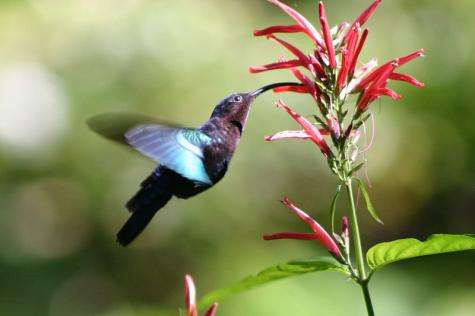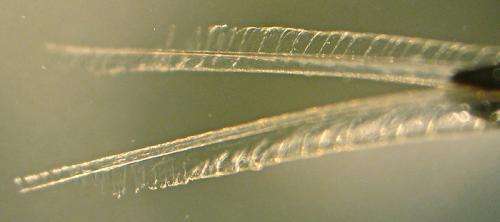May 3, 2011 report
How the hummingbird's tongue really works (w/ video)

(PhysOrg.com) -- Ornithologists first put forth the theory that hummingbirds took in nectar using capillary action (where liquid rises against gravity in a narrow tube) in 1833 and since then no one has questioned it. In a new study published in the Proceedings of the National Academy of Sciences, research has shown that it is not capillary action at all, but actually a curling of the tongue to trap liquid.
Associate professor of ecology Margaret A. Rubega and graduate student Alejandro Rico-Guevara from the University of Connecticut used a high-speed camera and see-through flowers they created to capture exactly what happens when hummingbirds drink nectar. They recorded 30 hummingbirds from 10 different species, as well as performed postmortem microscopic examinations of 20 other birds.
The hummingbird has a forked tongue which is lined with hair-like extensions called lamellae. When inside the flower, the tongue separates and the lamellae extend outward. As the bird pulls its tongue in, the tips come together and the lamellae roll inward. This action traps the nectar within the tongue.

They discovered during the postmortem examinations that this is a process that is automatic and requires no energy on the part of the bird. By manipulating the dead birds, they discovered that pulling the tongue past a liquids surface was enough to trigger the closing process.
Now that they have determined how the tongue works to collect the nectar, they plan to continue their research to determine how the birds are able to swallow. Their tongues can flick into nectar as much as 20 times per second so swallowing would need to be a rather quick action as well. Rico-Guevara plans to use X-ray microtomography to see exactly how swallowing takes place.
More information: The hummingbird tongue is a fluid trap, not a capillary tube, PNAS, print May 2, 2011, doi: 10.1073/pnas.1016944108 www.pnas.org/content/early/201 … /1016944108.abstract
Abstract
Hummingbird tongues pick up a liquid, calorie-dense food that cannot be grasped, a physical challenge that has long inspired the study of nectar-transport mechanics. Existing biophysical models predict optimal hummingbird foraging on the basis of equations that assume that fluid rises through the tongue in the same way as through capillary tubes. We demonstrate that the hummingbird tongue does not function like a pair of tiny, static tubes drawing up floral nectar via capillary action. Instead, we show that the tongue tip is a dynamic liquid-trapping device that changes configuration and shape dramatically as it moves in and out of fluids. We also show that the tongue–fluid interactions are identical in both living and dead birds, demonstrating that this mechanism is a function of the tongue structure itself, and therefore highly efficient because no energy expenditure by the bird is required to drive the opening and closing of the trap. Our results rule out previous conclusions from capillarity-based models of nectar feeding and highlight the necessity of developing a new biophysical model for nectar intake in hummingbirds. Our findings have ramifications for the study of feeding mechanics in other nectarivorous birds, and for the understanding of the evolution of nectarivory in general. We propose a conceptual mechanical explanation for this unique fluid-trapping capacity, with far-reaching practical applications (e.g., biomimetics).
© 2010 PhysOrg.com



















